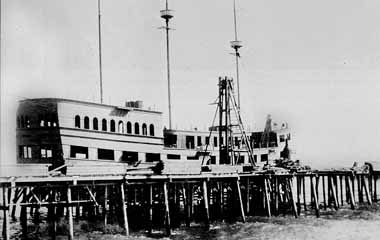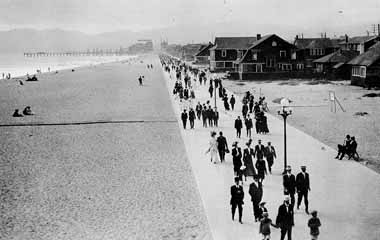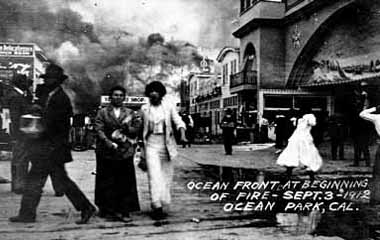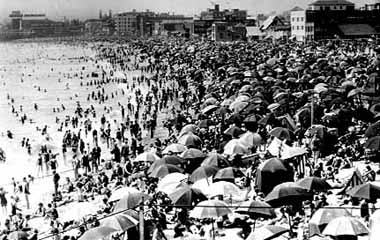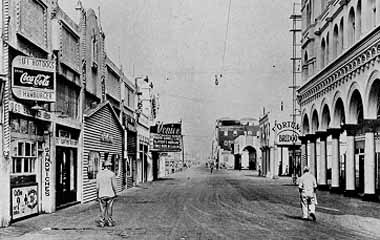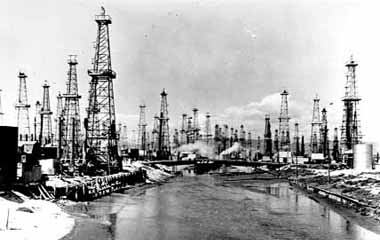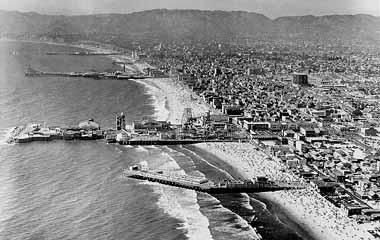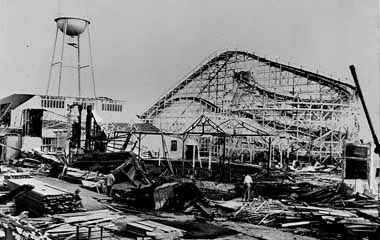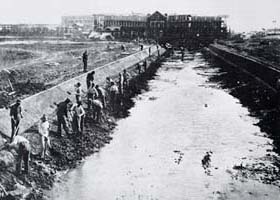 | The history of Venice of America - http://www.westland.net/venice/history.htm |
|
The Abbot Kinney Pier, May 1905 |
Ocean Front Walk in 1906 |
Fraser''s Pier burns to the ground after being open only a year |
|
Venice Beach in 1926 |
Depression - After the amusement piers were closed, Venice became deserted |
Venice becomes an oil boom town - View of the Grand Canal in 1930 |
|
the Sunset Pier, Venice Pier and Ocean Park Pier, 1941 |
the Kinney Company''s Venice Pier to be closed and demolished - 1946 |
Digging the canals in 1904 was back breaking work |
Birth of "Venice of America" (1890-1906)
In the 1890Õs, one manÕs dream of a renaissance resort and amusement park transformed a deteriorating marshland west of Los Angeles, California, into the "Coney Island of the Pacific". Despite disbelief and opposition, the dreams of Abbot Kinney materialized in grand style.
The vision of Abbot Kinney, a wealthy tobacco mogul, world traveler and co-owner of the Ocean Park Casino and Resort, was to turn the land south of Ocean Park through the Del Rey peninsula into a "Venice of America." He envisioned a resort town culturally reminiscent of Venice, Italy, complete with canals, gondolas, amusement piers, hotels and Venetian-styled structures. With the Casino thriving, Kinney and his partners purchased all the land south of Ocean Park. After the partnership dissolved, the split was determined by a flip of a coin and Kinney won the toss. He chose the marshy southern half of the property. With his family by his side, Kinney set out to accomplish his goal.
May 1905 - the pier. In September, The Los Angles Pacific Co. enabled inland LA residents to visit Venice by completing the first electric trolley line. By the year''s end, construction of the Ship Cafe and Auditorium, located on the Abbot Kinney Pier, the Venice Canals.
As the town was taking shape, Kinney felt the need to consolidate power and gain control of many of the concessions. And as expected, lawsuits followed, but Kinney persevered and won the majority of the cases. In 1907, Kinney faced a new battle when the Trustees who owned the rival Ocean Park Pier refused to issue him a building permit for his proposed ocean front bathhouse and Plunge. An outraged Kinney took matters into his own hands and began pouring the concrete foundations. The Sheriff attempted to dynamite the concrete foundation, but succumbed to the pressures of the woman''s Pick and Shovel Club when they picnicked on the site. The pool eventually opened in August and was free to the public.
In January, 1909, the Venice Aquarium opened on Kinney''s pier.The aquarium later became the official marine biological station for the University of Southern California.For the next few years construction of new attractions and theaters vitalized the area.
The Fraser''s Million Dollar amusement pier also opened claiming to be the largest in the world at 1250 feet long and 300 feet wide. The pier housed a spacious dance hall, two carousels, the Crooked House fun house, the Grand Electric Railroad, the Starland Vaudeville Theater, Breaker''s Restaurant and a Panama Canal model exhibit.
By 1920, Venice''s population reached 10,385 residents.
Sadly, on November 4, 1920, tobacco baron, Abbot Kinney died of lung cancer from years of heavy smoking, leaving his eldest son, Thornton, to take over the business. One month later, his amusement pier burned to the ground. The only attractions spared by the fire were a new roller coaster and the bandstand tower.
In 1930, oil was discovered on the Venice Peninsula. Within a year, 148 oil wells were producing over 40,000 barrels of oil daily. Jobs were created, but environmental destruction was wide spread and polluting the surrounding residential area and beaches.
In 1932 the Depression hit hard. Various Venice banks went bankrupt and the Venice Pier went into receivership. However, when liquor consumption became legal again and bingo games were modified into a game of skill, the economy benefited.
When World War II started, it affected Venice and it''s seaside amusement centers.During the daytime, Venice became a major draw for sailors and soldiers on weekend leave. Country Western and Swing music echoed from the dance halls and casino lounges. The evening curfew was eventually lifted in 1944 and life in Venice returned to normal.April 20, 1946 -the pier was ordered to be dismantled. Profitable or not, the cityĺs plan was to widen the beaches thus removing all piers.The Ocean Park Pier, however, thrived in the late 50''s after it was converted to a nautical theme park. (It remained in existence until 1967).
During the 50''s there was very popular the Lawrence Welk Band,who brought a new resurgence of business to the ailing dance halls and piers. A televised show made Welk a national celebrity. But by the end of the decade, pawn shops and liquor stores had replaced the souvenir shops and bingo parlors, and tourists were nowhere to be found.
A new group of people had made their way into the confines of Venice in the 60ĺs. The "Beats" as they were referred to brought a Bohemian life style. Life centered around art, poetry and new-jazz. Venice was tolerant of their life styles and they gathered in the local coffee houses. Where the Beats left off the Hippies took over. The flower children of the 60''s flocked to Venice to experience free expression during their "summer of love." The canals witnessed pot parties, love-ins and drunken frenzies. Several riots occurred during outdoor beach concerts with resulting arrests.
Venice experience a rebirth in the 70''s but not as a major tourist destination. The focal point was on maintaining the character of Venice so as not to chase out the low income population. In 1972, the city constructed an 18 mile bicycle path adjacent to Ocean Front Walk which extends from Torrance to Santa Monica. The new visitors were local residents riding bikes through the depressed Venice, bringing it new life. In 1974, nude sunbathing was actually permitted north of the Pavilion. It caused such a stir that the City of LA voted 14 to 1 to ban the fully exposed from sun bathing. This brought a new sight to Venice, the Los Angeles Police dressed in blue shorts and T-shirts enforcing the new law.
